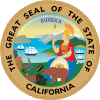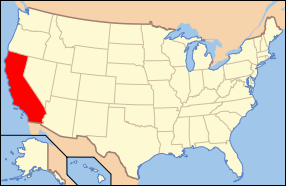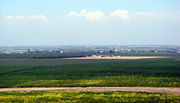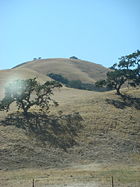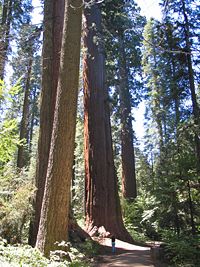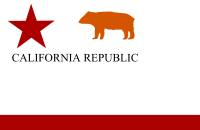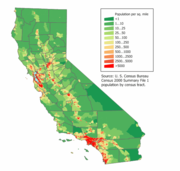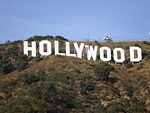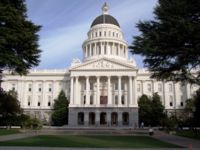California
2008/9 Schools Wikipedia Selection. Related subjects: North American Geography
| State of California | |||||||||||||
|
|||||||||||||
| Official language(s) | English | ||||||||||||
| Demonym | Californian | ||||||||||||
| Capital | Sacramento | ||||||||||||
| Largest city | Los Angeles | ||||||||||||
| Largest metro area | Greater Los Angeles | ||||||||||||
| Area | Ranked 3rd in the US | ||||||||||||
| - Total | 163,696 sq mi (423,970 km²) |
||||||||||||
| - Width | 250 miles (400 km) | ||||||||||||
| - Length | 770 miles (1,240 km) | ||||||||||||
| - % water | 4.7 | ||||||||||||
| - Latitude | 32° 32′ N to 42° N | ||||||||||||
| - Longitude | 114° 8′ W to 124° 26′ W | ||||||||||||
| Population | Ranked 1st in the US | ||||||||||||
| - Total | 36,553,215 (2007 est.) | ||||||||||||
| - Density | 233.8/sq mi 90.27/km² (12th in the US) |
||||||||||||
| - Median income | US$49,894 (13th) | ||||||||||||
| Elevation | |||||||||||||
| - Highest point | Mount Whitney 14,505 ft (4,421 m) |
||||||||||||
| - Mean | 2,900 ft (884 m) | ||||||||||||
| - Lowest point | Death Valley -282 ft (-86 m) |
||||||||||||
| Admission to Union | September 9, 1850 (31st) | ||||||||||||
| Governor | Arnold Schwarzenegger (R) | ||||||||||||
| Lieutenant Governor | John Garamendi (D) | ||||||||||||
| U.S. Senators | Dianne Feinstein (D) Barbara Boxer (D) |
||||||||||||
| Congressional Delegation | List | ||||||||||||
| Time zone | Pacific: UTC-8/ -7 | ||||||||||||
| Abbreviations | CA Calif. US-CA | ||||||||||||
| Website | ca.gov | ||||||||||||
California (IPA: /ˌkælɪˈfɔrnjə/) is a state on the West Coast of the United States, along the Pacific Ocean. It is the most populous U.S. state. Its four largest cities are Los Angeles, San Diego, San Jose, and San Francisco. It is known for its varied climate and geography as well as its diverse population.
The area known as Alta California was colonized by the Spanish Empire beginning in the late 18th century. It and the rest of Mexico became an independent republic in 1821. In 1846 California broke away from Mexico, and after the Mexican-American War, Mexico ceded California to the United States. It was admitted to the Union on September 9, 1850.
It is the third-largest U.S. state by land area. Its geography ranges from the Pacific coast to the Sierra Nevada mountains in the east, to desert areas in the southeast and the forests of the northwest. The centre of the state is dominated by the Central Valley, one of the most productive agricultural areas in the world.
The California Gold Rush began in 1848, dramatically changing California with a large influx of people and an economic boom. The early 20th century was marked by Los Angeles becoming the centre of the entertainment industry, in addition to the growth of a large tourism sector in the state. Along with California's prosperous agricultural industry, other industries include aerospace, petroleum, and computer and information technology. California ranks among the ten largest economies in the world, and were it a separate country, it would be 34th among the most populous countries, just behind Poland.
Etymology
| California state insignia | |
|---|---|
| Motto | Eureka! (I've found it!) |
| Slogan | Find Yourself Here |
| Bird | California Quail |
| Animal | California grizzly bear (extinct/subspecies extinct in this range) |
| Fish | Golden Trout |
| Insect | California Dogface Butterfly |
| Flower | California Poppy |
| Tree | California Redwood |
| Song | " I Love You, California" |
| Quarter | 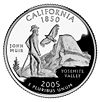 2005 |
| Butterfly | California Dogface Butterfly |
| Grass | Purple Needlegrass |
| Reptile | Desert Tortoise |
| Wildflower | California Poppy |
| Beverage | Wine |
| Colors | Blue & Gold |
| Dance | West Coast Swing |
| Fossil | Sabre-toothed cat |
| Gemstone | Benitoite |
| Mineral | Native Gold |
| Soil | San Joaquin |
| Tartan | California State Tartan |
The word California originally referred to the entire region composed of the current U.S. state of California, plus all or parts of Nevada, Utah, Arizona, and Wyoming, and the Mexican peninsula now known as Baja California.
The name California is most commonly believed to have derived from a storied paradise peopled by black Amazons and ruled by Queen Califia. The myth of Califia is recorded in a 1510 work The Exploits of Esplandian, written as a sequel to Amadís de Gaula by Spanish adventure writer García Ordóñez Rodríguez de Montalvo. The kingdom of Queen Califia, according to Montalvo, was said to be a remote land inhabited by griffins and other strange beasts and rich in gold.
| “ | Know ye that at the right hand of the Indies there is an island named California, very close to that part of the terrestrial Paradise, which was inhabited by black women, without a single man among them, and that they lived in the manner of Amazons. They were robust of body, with strong and passionate hearts and great virtues. The island itself is one of the wildest in the world on account of the bold and craggy rocks. Their weapons were all made of gold. The island everywhere abounds with gold and precious stones, and upon it no other metal was found. | ” |
Geography and environment
California adjoins the Pacific Ocean, Oregon, Nevada, Arizona, and the Mexican state of Baja California. With an area of 160,000 mi² (411,000 km²) it is the third largest state in the United States in size, after Alaska and Texas. If it were a country, California would be the 59th largest in the world, between Iraq and Paraguay.
In the middle of the state lies the California Central Valley, bounded by the coastal mountain ranges in the west, the Sierra Nevada to the east, the Cascade Range in the north and the Tehachapi Mountains in the south. The Central Valley is California's agricultural heartland and grows approximately one-third of the nation's food. Divided in two by the Sacramento-San Joaquin River Delta, the northern portion, the Sacramento Valley serves as the watershed of the Sacramento River, while the southern portion, the San Joaquin Valley is the watershed for the San Joaquin River; both areas derive their names from the rivers that transit them. With dredging, the Sacramento and the San Joaquin Rivers have remained sufficiently deep that several inland cities are seaports. The Sacramento-San Joaquin Bay Delta serves as a critical water supply hub for the state. Water is routed through an extensive network of canals and pumps out of the delta, that traverse nearly the length of the state, including the Central Valley Project, and the State Water Project. Water from the Sacramento-San Joaquin Bay Delta provides drinking water for nearly 23 million people, almost two-thirds of the state's population, and provides water to farmers on the west side of the San Joaquin Valley. The Channel Islands are located off the southern coast.
The Sierra Nevada (Spanish for "snowy range") include the highest peak in the contiguous forty-eight states, Mount Whitney, at 14,505 ft (4,421 m). The range embraces Yosemite Valley, famous for its glacially carved domes, and Sequoia National Park, home to the giant sequoia trees, the largest living organisms on Earth, and the deep freshwater lake, Lake Tahoe, the largest lake in the state by volume.
The state is home to Mount Whitney, the highest point in the contiguous United States, as well as the second lowest and hottest place in the Western Hemisphere, Death Valley.
To the east of the Sierra Nevada are Owens Valley and Mono Lake, an essential migratory bird habitat. In the western part of the state is Clear Lake, the largest freshwater lake by area entirely in California. Though Lake Tahoe is larger, it is divided by the California/Nevada border. The Sierra Nevada falls to Arctic temperatures in winter and has several dozen small glaciers, including Palisade Glacier, the southernmost glacier in the United States.
About 35% of the state's total surface area is covered by forests, and California's diversity of pine species is unmatched by any other state. California contains more forestland than any other state except Alaska. Many of the trees in the California White Mountains are the oldest in the world; one Bristlecone pine has an age of 4,700 years.
In the south is a large inland salt lake, the Salton Sea. Deserts in California make up about 25% of the total surface area. The south-central desert is called the Mojave; to the northeast of the Mojave lies Death Valley, which contains the lowest, hottest point in North America, Badwater Flat. The distance from the lowest point of Death Valley to the peak of Mount Whitney is less than 200 miles (322 km). Indeed, almost all of southeastern California is arid, hot desert, with routine extreme high temperatures during the summer.
Along the California coast are several major metropolitan areas, including Greater Los Angeles, the San Francisco Bay Area, and San Diego.
California is famous for earthquakes due to a number of faults, in particular the San Andreas Fault. It is vulnerable to tsunamis, floods, droughts, Santa Ana winds, wildfires, and landslides on steep terrain, and has several volcanoes.
Climate
California climate varies from Mediterranean to subarctic. Much of the state has a Mediterranean climate, with cool, rainy winters and dry summers. The cool California Current offshore often creates summer fog near the coast. Further inland, one encounters colder winters and hotter summers.
Northern parts of the state average higher annual rainfall than the south. California's mountain ranges influence the climate as well: some of the rainiest parts of the state are west-facing mountain slopes. Northwestern California has a temperate climate, and the Central Valley has a Mediterranean climate but with greater temperature extremes than the coast. The high mountains, including the Sierra Nevada, have a mountain climate with snow in winter and mild to moderate heat in summer.
The east side of California's mountains has a drier rain shadow. The low deserts east of the southern California mountains experience hot summers and nearly frostless mild winters; the higher elevation deserts of eastern California see hot summers and cold winters. In Death Valley, the highest temperature in the Western Hemisphere, 134 °F (56.6 °C), was recorded July 10, 1913.
Ecology
Ecologically, California is one of the richest and most diverse parts of the world and includes some of the most endangered ecological communities. California is part of the Nearctic ecozone and spans a number of terrestrial ecoregions.
California's large number of endemic species includes relict species which have died out elsewhere, such as the Catalina Ironwood (Lyonothamnus floribundus). Many other endemics originated through differentiation or adaptive radiation, whereby multiple species develop from a common ancestor to take advantage of diverse ecological conditions such as the California lilac ( Ceanothus). Many California endemics have become endangered, as urbanization, logging, overgrazing, and the introduction of exotic species have encroached on their habitat.
California boasts several superlatives in its collection of flora; the largest trees, the tallest trees, and the oldest trees. California's native grasses are perennial plants. After European contact, these were generally replaced by invasive species of European annual grasses; and, in modern times, California's hills turn a characteristic golden brown in summer.
Rivers
Arguably, the two most prominent rivers within California are the Sacramento River and the San Joaquin River, which drain the Central Valley and flow to the Pacific Ocean through San Francisco Bay. Two other important rivers are the Klamath River, in the north, and the Colorado River, on the southeast border.
Protected areas
History
 |
| History of California |
|---|
| To 1899 |
| Gold Rush (1848) |
| American Civil War (1861-1865) |
| 1900 to present |
| Maritime |
| Railroad |
| Slavery |
| Los Angeles |
| Sacramento |
| San Diego |
| San Francisco |
| San Jose |
Settled by successive waves of arrivals during the last 10,000 years, California was one of the most culturally and linguistically diverse areas in pre-Columbian North America; the area was inhabited by more than 70 distinct groups of Native Americans. Large, settled populations lived on the coast and hunted sea mammals, fished for salmon, and gathered shellfish, while groups in the interior hunted terrestrial game and gathered nuts, acorns, and berries. California groups also were diverse in their political organization with bands, tribes, villages, and on the resource-rich coasts, large chiefdoms, such as the Chumash, Pomo and Salinan. Trade, intermarriage, and military alliances fostered many social and economic relationships among the diverse groups.
The first European to explore the coast as far north as the Russian River was the Portuguese João Rodrigues Cabrilho, in 1542, sailing for the Spanish Empire. Some 37 years later, the English explorer Francis Drake also explored and claimed an undefined portion of the California coast in 1579. Spanish traders made unintended visits with the Manila Galleons on their return trips from the Philippines beginning in 1565. Sebastián Vizcaíno explored and mapped the coast of California in 1602 for New Spain.
Spanish missionaries began setting up twenty-one California Missions along the coast of what became known as Alta California (Upper California), together with small towns and presidios. The first mission in Alta California was established at San Diego in 1769. In 1821, the Mexican War of Independence gave Mexico (including California), independence from Spain; for the next twenty-five years, Alta California remained a remote northern province of the nation of Mexico. Cattle ranches, or ranchos, emerged as the dominant institutions of Mexican California. After Mexican independence from Spain, the chain of missions became the property of the Mexican government and were secularized by 1832. The ranchos developed under ownership by Californios (Spanish-speaking Californians) who had received land grants and traded cowhides and tallow with Boston merchants.
Beginning in the 1820s, trappers and settlers from the United States and Canada began to arrive in Northern California, harbingers of the great changes that would later sweep the Mexican territory. These new arrivals used the Siskiyou Trail, California Trail, Oregon Trail, and Old Spanish Trail to cross the rugged mountains and harsh deserts surrounding California. In this period, Imperial Russia explored the California coast and established a trading post at Fort Ross.
In 1846, settlers rebelled against Mexican rule during the Bear Flag Revolt. Afterwards, rebels raised the Bear Flag (featuring a bear, a star, a red stripe, and the words "California Republic") at Sonoma.
| “ | [we] overthrow a Government which has seized upon the property of the Missions for its individual aggrandizement; which has ruined and shamefully oppressed the laboring people of California | ” |
|
—William Ide, Declaration from the Bear Flag Revolt |
||
The Republic's first and only president was William B. Ide, who played a pivotal role during the Bear Flag Revolt. His term lasted twenty-five days and concluded when California was occupied by U.S. forces during the Mexican-American War.
The California Republic was short lived. The same year marked the outbreak of the Mexican-American War (1846-1848). When Commodore John D. Sloat of the United States Navy sailed into Monterey Bay and began the military occupation of California by the United States. Northern California capitulated in less than a month to the U.S. forces.
Following a series of defensive battles in Southern California, including The Siege of Los Angeles, the Battle of Dominguez Rancho, the Battle of San Pascual, the Battle of Rio San Gabriel, and the Battle of La Mesa, the Treaty of Cahuenga was signed by the Californios on January 13, 1847, securing American control in California.
Following the Treaty of Guadalupe Hidalgo that ended the war, the region was divided between Mexico and the United States; the western territory of Alta California, was to become the U.S. state of California, and Arizona, Nevada, Colorado and Utah became U.S. Territories, while the lower region of California, Baja California, remained in the possession of Mexico.
In 1848, the non-native population of California has been estimated to be no more than 15,000. But after gold was discovered, the population burgeoned with U.S. citizens, Europeans, and other immigrants during the great California Gold Rush. On September 9, 1850, as part of the Compromise of 1850, California was admitted to the United States as a free state (one in which slavery was prohibited).
The seat of government for California under Mexican rule was located at Monterey from 1777 until 1835, when Mexican authorities abandoned California, leaving their missions and military forts behind. In 1849, the Constitutional Convention was first held there. Among the duties was the task of determining the location for the new State capital. The first legislative sessions were held in San Jose (1850-1851). Subsequent locations included Vallejo (1852-1853), and nearby Benicia (1853-1854), although these locations eventually proved to be inadequate as well. The capital has been located in Sacramento since 1854.
Travel between California and the central and eastern parts of the United States was time-consuming and dangerous. A more direct connection came in 1869 with the completion of the First Transcontinental Railroad through Donner Pass in the Sierra Nevada mountains. After this rail link was established, hundreds of thousands of U.S. citizens came west, where new Californians were discovering that land in the state, if irrigated during the dry summer months, was extremely well-suited to fruit cultivation and agriculture in general. Vast expanses of wheat and other cereal crops, vegetable crops, cotton, and nut and fruit trees were grown (including oranges in Southern California), and the foundation was laid for the state's prodigious agricultural production in the Central Valley and elsewhere.
During the early 20th century, migration to California accelerated with the completion of major transcontinental highways like the Lincoln Highway and Route 66. In the period from 1900 to 1965, the population grew from fewer than one million to become the most populous state in the Union. From 1965 to the present, the population changed radically and became one of the most diverse in the world. The state is regarded as a world center of technology and engineering businesses, of the entertainment and music industries, and as the U.S. centre of agricultural production.
Demographics
Population
| Historical populations | |||
|---|---|---|---|
| Census | Pop. | %± | |
| 1850 | 92,597 |
|
|
| 1860 | 379,994 | 310.4% | |
| 1870 | 560,247 | 47.4% | |
| 1880 | 864,694 | 54.3% | |
| 1890 | 1,213,398 | 40.3% | |
| 1900 | 1,485,053 | 22.4% | |
| 1910 | 2,377,549 | 60.1% | |
| 1920 | 3,426,861 | 44.1% | |
| 1930 | 5,677,251 | 65.7% | |
| 1940 | 6,907,387 | 21.7% | |
| 1950 | 10,586,223 | 53.3% | |
| 1960 | 15,717,204 | 48.5% | |
| 1970 | 19,953,134 | 27% | |
| 1980 | 23,667,902 | 18.6% | |
| 1990 | 29,760,021 | 25.7% | |
| 2000 | 33,871,648 | 13.8% | |
| Est. 2007 | 36,553,215 | 7.9% | |
By 2007, California's population is estimated at 36,553,215, making it the most populated state and the 13th fastest-growing state. This includes a natural increase since the last census of 1,909,368 people (that is 3,375,297 births minus 1,465,929 deaths) and an increase due to net migration of 774,198 people into the state. Immigration from outside the United States resulted in a net increase of 1,724,790 people, and migration within the country produced a net decrease of 950,592.
California is the second most populous state of the Americas, exceeded only by São Paulo State, Brazil. More than 12 percent of U.S. citizens live in California and its population is greater than that of all but 34 countries of the world.
California has eight of the top 50 US cities in terms of population. Los Angeles is the nation's second-largest city with a population of 3,849,378 people, followed by San Diego (8th), San Jose (10th), San Francisco (14th), Long Beach (34th), Fresno (36th), Sacramento (37th) and Oakland (44th). Los Angeles County has held the title of most populous county for decades, and is more populous than 42 US states.
The centre of population of California is at the town of Buttonwillow in Kern County.
Racial and ancestral makeup
According to the 2006 ACS Estimates, California's population is:
- 59.8% White American - includes 17.5% White Hispanic,
- 6.2% Black or African American,
- 12.3% Asian American,
- 0.7% American Indian,
- 3.3% mixed, and the remaining 17.3% are of Some other Race.
- 35.9% are Hispanic or Latino (of any race).
California has the largest population of White Americans in the U.S., an estimated 21,810,156 residents. The fifth largest population of African Americans in the U.S., an estimated 2,260,648 residents. California's Asian population is estimated at 4.5 million, approximately one-third of the nation's 14.9 million Asian Americans. California's Native American population of 376,093 is the most of any state.
According to estimates from 2006, California has the largest minority population in the United States, making up 57% of the state population. Non-Hispanic whites decreased from 80% of the state's population in 1970 to 43% in 2006. While the population of minorities accounts for 100.7 million of 300 million U.S. residents, 21% of the national total live in California.
Languages
As of 2000, 60.52% of California residents age five and older spoke English as a first language at home, while 25.80% spoke Spanish. In addition to English and Spanish, 2.44% spoke Chinese (which included Cantonese [0.48%] and Mandarin [0.29%]), 1.99% spoke Filipino (most are native speakers of Ilokano, Cebuano, Tagalog, Pangasinan and Kapampangan), 1.29% spoke Vietnamese, and 0.94% spoke Korean as their mother tongue. In total, 39.47% of the population spoke languages other than English. Over 200 languages are known to be spoken and read in California. Including indigenous languages, California is viewed as one of the most linguistically diverse areas in the world (the indigenous languages were derived from 64 root languages in 6 language families). About half of the indigenous languages are no longer spoken, and all of California's living indigenous languages are endangered, although there are now some efforts toward language revitalization.
The official language of California has been English since the passage of Proposition 63 in 1986. However, many state, city, and local government agencies still continue to print official public documents in numerous languages.
Religion
The state has the most Roman Catholics of any state and a large Protestant population, a large American Jewish community, and an American Muslim population.
With a Jewish population estimated at more than 550,000, Los Angeles is the second-largest Jewish community in North America.
California also has the largest Muslim community population in the United States, an estimated 3.4% of the population, mostly residing in Southern California. According to figures, approximately 100,000 Muslims reside in San Diego.
As the twentieth century came to a close, forty percent of all Buddhists in America resided in Southern California. The Los Angeles Metropolitan Area has become unique in the Buddhist world as the only place where representative organizations of every major school of Buddhism can be found in a single urban centre. The City of Ten Thousand Buddhas in Northern California and Hsi Lai Temple in Southern California are two of the largest Buddhist temples in the Western Hemisphere. It also has a growing Hindu population.
California also has more Temples of The Church of Jesus Christ of Latter-day Saints than any state except Utah.
Economy
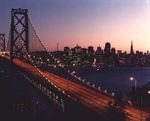
As of 2006, the gross state product (GSP) is about $1.727 trillion, the largest in the United States. California is responsible for 13% of the United States gross domestic product (GDP). As of 2006, California's GDP is larger than all but eight countries in the world (and all but eleven countries by Purchasing Power Parity). California is facing a $16 billion budget deficit for the 2008-09 budget year.
California is also the home of several significant economic regions, such as Hollywood (entertainment), the California Central Valley (agriculture), the Silicon Valley and Tech Coast (computers and high tech), and wine producing regions, such as the Napa Valley, Sonoma Valley and Southern California's Santa Barbara and Paso Robles areas.
The predominant industry, more than twice as large as the next, is agriculture, (including fruit, vegetables, dairy, and wine). This is followed by aerospace; entertainment, primarily television by dollar volume, although many movies are still made in California; music production and recording studios; light manufacturing, including computer hardware and software; and the mining of borax. Oil drilling has played a significant role in the development of the state.
Per capita personal income was $38,956 as of 2006, ranking 11th in the nation. Per capita income varies widely by geographic region and profession. The Central Valley is the most impoverished, with migrant farm workers making less than minimum wage. Recently, the San Joaquin Valley was characterized as one of the most economically depressed regions in the U.S., on par with the region of Appalachia.
Many coastal cities include some of the wealthiest per-capita areas in the U.S. The high-technology sectors in Northern California, specifically Silicon Valley, in Santa Clara and San Mateo counties, are currently emerging from economic downturn caused by the dot.com bust, which caused the loss of over 250,000 jobs in Northern California alone. As of spring 2005, economic growth has resumed in California at 4.3%.
California levies a 9.3% maximum variable rate income tax, with 6 tax brackets. It collects about $40 billion per year in income taxes. California's combined state, county and local sales tax rate is from 7.25 to 8.75%. The rate varies throughout the state at the local level. In all, it collects about $28 billion in sales taxes per year. All real property is taxable annually, the tax based on the property's fair market value at the time of purchase. This tax does not increase based on a rise in real property values (see Proposition 13). California collects $33 billion in property taxes per year.
Energy
Petroleum
California’s crude oil output accounts for more than one-tenth of total U.S. production. Drilling operations are concentrated primarily in Kern County and the Los Angeles basin. Although there is also substantial offshore oil and gas production, there is a permanent moratorium on new offshore oil and gas leasing in California waters and a deferral of leasing in Federal waters.
California ranks third in the United States in petroleum refining capacity and accounts for more than one-tenth of total U.S. capacity. In addition to oil from California, California’s refineries process crude oil from Alaska and foreign suppliers. The refineries are configured to produce cleaner fuels, including reformulated motor gasoline and low-sulfur diesel, to meet strict Federal and State environmental regulations.
Most California motorists are required to use a special motor gasoline blend called California Clean Burning Gasoline (CA CBG). By 2004, California completed a transition from methyl tertiary butyl-ether (MTBE) to ethanol as a gasoline oxygenate additive, making California the largest ethanol fuel market in the United States. There are four ethanol production plants in central and southern California, but most of California’s ethanol supply is transported from other states or abroad.
Natural gas
California natural gas production typically is less than 2 percent of total annual U.S. production and satisfies less than one-fifth of state demand. California receives most of its natural gas by pipeline from production regions in the Rocky Mountains, the Southwest, and western Canada.
Electricity
Natural gas-fired power plants typically account for more than one-half of State electricity generation. California is one of the largest hydroelectric power producers in the United States, and with adequate rainfall, hydroelectric power typically accounts for close to one-fifth of State electricity generation. Due to strict emission laws, only a few small coal-fired power plants operate in California.
The Mojave Desert is one of the best sites in the United States for solar power plants. Solar insolation is very high and significant population centers are located in the area. Two prototype systems known as "Solar One" and "Solar Two" produced 10 MW each when they were in operation.
California’s two nuclear power plants account for almost one-fifth of total generation, these are:
- Diablo Canyon Power Plant: 2 reactors. Operated and owned by Pacific Gas & Electric Co.
- San Onofre Nuclear Generating Station : 2 reactors. Operated by Southern California Edison with various owners (SCE; San Diego Gas and Electric; City of Anaheim and the City of Riverside).
California leads the United States in electricity generation from nonhydroelectric renewable energy sources, such as wind, geothermal, solar energy, fuel wood, and municipal solid waste/landfill gas resources. A facility known as “The Geysers,” located in the Mayacamas Mountains north of San Francisco, is the largest group of geothermal power plants in the world, with more than 750 megawatts of installed capacity. Due to high electricity demand, California imports more electricity than any other state, primarily hydroelectric power from states in the Pacific Northwest (via Path 15 and Path 66) and coal- and natural gas-fired production from the desert Southwest via Path 46.
Transportation
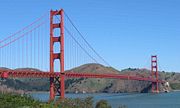
California's vast terrain is connected by an extensive system of freeways, expressways, and highways. California is known for its car culture, giving California's cities a reputation for severe traffic congestion. Construction and maintenance of state roads and statewide transportation planning are primarily the responsibility of the California Department of Transportation (Caltrans).
One of the state's more visible landmarks, the Golden Gate Bridge was completed in 1937. With its orange paint and panoramic views of the bay, this highway bridge is a popular tourist attraction and also accommodates pedestrians and bicyclists. It is simultaneously designated as U.S. Route 101 which is part of the El Camino Real (Spanish for Royal Road or King's Highway), and State Route 1 which is also known as the Pacific Coast Highway. Another of the seven bridges in the San Francisco Bay Area is the San Francisco-Oakland Bay Bridge, completed in 1936. This bridge transports approximately 280,000 vehicles per day on two-decks, with its two sections meeting at Yerba Buena Island.
Los Angeles International Airport and San Francisco International Airport are major hubs for trans-Pacific and transcontinental traffic. There are about a dozen important commercial airports and many more general aviation airports throughout the state.
California also has several important seaports. The giant seaport complex formed by the Port of Los Angeles and the Port of Long Beach in Southern California is the largest in the country and responsible for handling about a fourth of all container cargo traffic in the United States. The Port of Oakland, fourth largest in the nation, handles trade from the Pacific Rim and delivers most of the ocean containers passing through Northern California to the entire USA.
Intercity rail travel is provided by Amtrak. Los Angeles and San Francisco both have subway networks, in addition to light rail. Metrolink commuter rail and Metro Rail part of METRO serves much of Southern California, and BART and Caltrain commuter rail connect Bay Area suburbs to San Francisco. San Jose and Sacramento have light rail, and San Diego has Trolley light rail and Coaster commuter rail services. Nearly all counties operate bus lines, and many cities operate their own bus lines as well. Intercity bus travel is provided by Greyhound and Amtrak bus services.
The rapidly growing population of the state is straining all of its transportation networks. A regularly recurring issue in California politics is whether the state should continue to aggressively expand its freeway network or concentrate on improving mass transit networks in urban areas.
The California High Speed Rail Authority was created in 1996 by the state to implement an extensive 700 mile (1127 km) rail system. Construction is pending approval of the voters during the November 2008 general election, in which a $9 billion state bond would have to be approved.
Government & politics
State government
California is governed as a republic, with three branches of government: the executive branch consisting of the Governor of California and the other independently elected constitutional officers; the legislative branch consisting of the Assembly and Senate; and the judicial branch consisting of the Supreme Court of California and lower courts. The state also allows direct participation of the electorate by initiative, referendum, recall, and ratification. California follows a closed primary system. The state's capital is Sacramento.
| Year | Republican | Democratic |
|---|---|---|
| 2006 | 55.88% 4,850,157 | 38.91% 3,376,732 |
| 2002 | 42.41% 3,169,801 | 47.28% 3,533,490 |
| 1998 | 38.38% 3,216,749 | 57.97% 4,858,817 |
| 1994 | 55.18% 4,781,766 | 40.62% 3,519,799 |
| 1990 | 49.25% 3,791,904 | 45.78% 3,525,197 |
| 1986 | 61.25% 4,505,601 | 37.58% 2,781,714 |
The Governor of California and the other state constitutional officers serve four-year terms and may be re-elected only once. The California State Legislature consists of a 40 member Senate and 80 member Assembly. Senators serve four year terms and Assembly members two. Members of the Assembly are subject to term limits of three terms, and members of the Senate are subject to term limits of two terms.
For the 2007 — 2008 session, there are 48 Democrats and 32 Republicans in the Assembly. In the Senate, there are 25 Democrats and 15 Republicans. The current governor is Republican Arnold Schwarzenegger, who was elected to a term that lasts through January 2011.
California's judiciary is the largest in the United States (with a total of 1,600 judges, while the federal system has only about 840). It is supervised by the seven Justices of the Supreme Court of California. Justices of the Supreme Court and Courts of Appeal are appointed by the Governor, but are subject to retention by the electorate every 12 years.
Federal politics
| Year | Republican | Democratic |
|---|---|---|
| 2004 | 44.36% 5,509,826 | 54.40% 6,745,485 |
| 2000 | 41.65% 4,567,429 | 53.45% 5,861,203 |
| 1996 | 38.21% 3,828,380 | 51.10% 5,119,835 |
| 1992 | 32.61% 3,630,574 | 46.01% 5,121,325 |
| 1988 | 51.13% 5,054,917 | 47.56% 4,702,233 |
| 1984 | 57.51% 5,467,009 | 41.27% 3,922,519 |
| 1980 | 52.69% 4,524,858 | 35.91% 3,083,661 |
California has an idiosyncratic political culture. It was the second state to legalize abortion and the second state to legalize marriage for gay couples. It was also the first state where voters decided that only marriage between a man and a woman would be recognized (legalized domestic partnerships were not approved by voters, but were made law by the state legislature).
Since 1990, California has generally elected Democratic candidates; however, the state has had little hesitance in electing Republican Governors, though many of its Republican Governors, such as the current Governor Schwarzenegger, tend to be considered "Moderate Republicans" and tend to be more liberal than the party itself.
Democratic strength is centered in coastal regions of Los Angeles County and the San Francisco Bay Area. The Democrats also hold a majority in Sacramento. The Republican strength is greatest in the San Joaquin Valley, which includes the growing cities of Stockton and Modesto. Orange County remains mostly Republican.
Overall, the trend in California politics has been towards the Democratic Party and away from the Republican Party. The trend is most obvious in presidential elections. Additionally, the Democrats have easily won every U.S. Senate race since 1992 and have maintained consistent majorities in both houses of the state legislature. In the U.S. House, the Democrats hold a 34-19 edge for the 110th United States Congress. The U.S senators are Dianne Feinstein (D), a native of San Francisco, and Barbara Boxer (D). The districts in California are assigned to voters in such a way that they were dominated by one or the other party with few districts that could be considered competitive. According to political analysts, California should soon gain three more seats, for a total of 58 electoral votes - the most electoral votes in the nation.
California state law
California's legal system is explicitly based on English common law (as is the case with all other states except Louisiana) but carries a few features from Spanish civil law, such as community property. Capital punishment is a legal form of punishment and the state has the largest " Death Row" population in the country (though Texas is far more active in carrying out executions). California's "Death Row" is currently located in San Quentin State Prison situated north of San Francisco in Marin County. Currently capital punishment is on hold in the courts in California.
Cities, towns and counties
- For lists of cities, towns, and counties in California, see List of cities in California (by population), List of cities in California, List of urbanized areas in California (by population), List of counties in California, and California locations by per capita income.
The state is divided into 58 counties.
California has 478 incorporated cities and towns, of which 456 are cities and 22 are towns. Under California law, the terms "city" and "town" are explicitly interchangeable; the name of an incorporated municipality in the state can either be "City of (Name)" or "Town of (Name)."
The majority of these cities and towns are within one of five metropolitan areas. Sixty-eight percent of California's population lives in its three largest metropolitan areas, Greater Los Angeles, the San Francisco Bay Area and the Riverside-San Bernardino Area, known as the Inland Empire. Although smaller, the other two large population centers are the San Diego and the Sacramento metro areas. California is home to the largest county in the contiguous United States by area, San Bernardino County.
The state recognizes two kinds of cities-- charter and general law. General law cities owe their existence to state law and consequentially governed by it; charter cities are governed by their own city charters. Cities incorporated in the 19th century tend to be charter cities. All of the state's ten most populous cities are charter cities.
Education
California offers a unique three-tier system of public postsecondary education:
- The preeminent research university system in the state is the University of California (UC) which employs more Nobel Prize laureates than any other institution in the world, and is considered one of the world's finest public university systems. There are ten general UC campuses, and a number of specialized campuses in the UC system.
- The California State University (CSU) system has over 400,000 students, making it the largest university system in the United States. It is intended to accept the top one-third (1/3) of high school students. The CSU schools are primarily intended for undergraduate education.
- The California Community Colleges system provides lower division courses. It is composed of 109 colleges, serving a student population of over 2.9 million.
California is also home to such notable private universities and colleges as Stanford University, the University of Southern California (USC), the California Institute of Technology (Caltech), Occidental College, and the Claremont Colleges. California has hundreds of other private colleges and universities, including many religious and special-purpose institutions.
Public secondary education consists of high schools that teach elective courses in trades, languages, and liberal arts with tracks for gifted, college-bound and industrial arts students. California's public educational system is supported by a unique constitutional amendment that requires 40% of state revenues to be spent on education.
Sports
California hosted the 1960 Winter Olympics at Squaw Valley Ski Resort, the 1932 and 1984 Summer Olympics in Los Angeles, as well as the 1994 FIFA World Cup.
California has nineteen major professional sports league franchises, far more than any other state. The San Francisco Bay Area has seven major league teams spread in three cities, San Francisco, Oakland and San Jose. While the Greater Los Angeles Area is home to ten major league franchises, it is also the largest metropolitan area not to have a team from the National Football League. San Diego has two major league teams, and Sacramento also has two.
Home to some of most prominent universities in the United States, California has long had many respected collegiate sports programs. In particular, the athletic programs of UC Berkeley, USC, UCLA, Stanford and Fresno State are often nationally ranked in the various collegiate sports. California is also home to the oldest college bowl game, the annual Rose Bowl, and the Holiday Bowl, among others.
Below is a list of major sports teams in California:
| Club | Sport | League |
|---|---|---|
| Oakland Raiders | Football | National Football League |
| San Diego Chargers | Football | National Football League |
| San Francisco 49ers | Football | National Football League |
| Los Angeles Angels of Anaheim | Baseball | Major League Baseball |
| Los Angeles Dodgers | Baseball | Major League Baseball |
| Oakland Athletics | Baseball | Major League Baseball |
| San Diego Padres | Baseball | Major League Baseball |
| San Francisco Giants | Baseball | Major League Baseball |
| Golden State Warriors | Basketball | National Basketball Association |
| Los Angeles Clippers | Basketball | National Basketball Association |
| Los Angeles Lakers | Basketball | National Basketball Association |
| Sacramento Kings | Basketball | National Basketball Association |
| Anaheim Ducks | Ice Hockey | National Hockey League |
| Los Angeles Kings | Ice Hockey | National Hockey League |
| San Jose Sharks | Ice Hockey | National Hockey League |
| Chivas USA | Soccer | Major League Soccer |
| Los Angeles Galaxy | Soccer | Major League Soccer |
| San Jose Earthquakes | Soccer | Major League Soccer |
| Los Angeles Avengers | Football | Arena Football League |
| San Jose SaberCats | Football | Arena Football League |
| Los Angeles Sparks | Basketball | Women's National Basketball Association |
| Sacramento Monarchs | Basketball | Women's National Basketball Association |
| Los Angeles Riptide | Lacrosse | Major League Lacrosse |
| San Francisco Dragons | Lacrosse | Major League Lacrosse |
| San Jose Stealth | Lacrosse | National Lacrosse League |
| California Cougars | Soccer | Major Indoor Soccer League |

